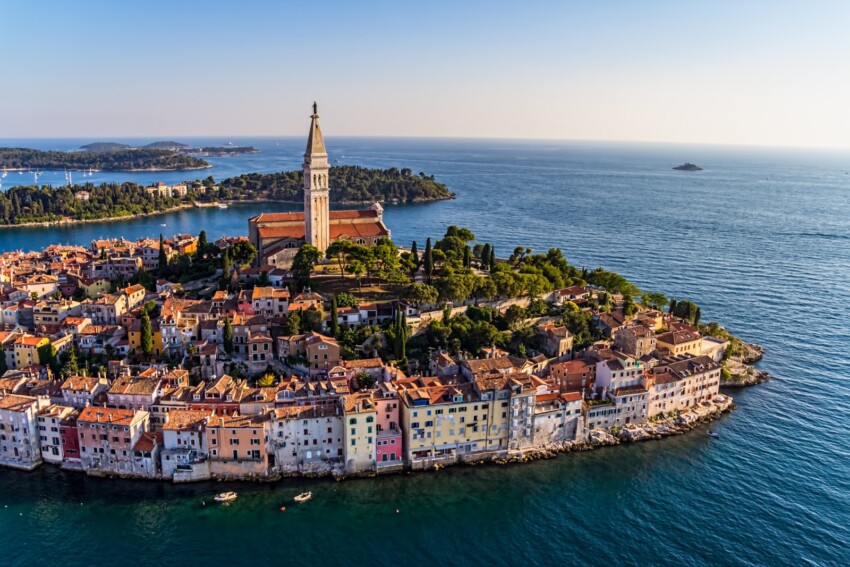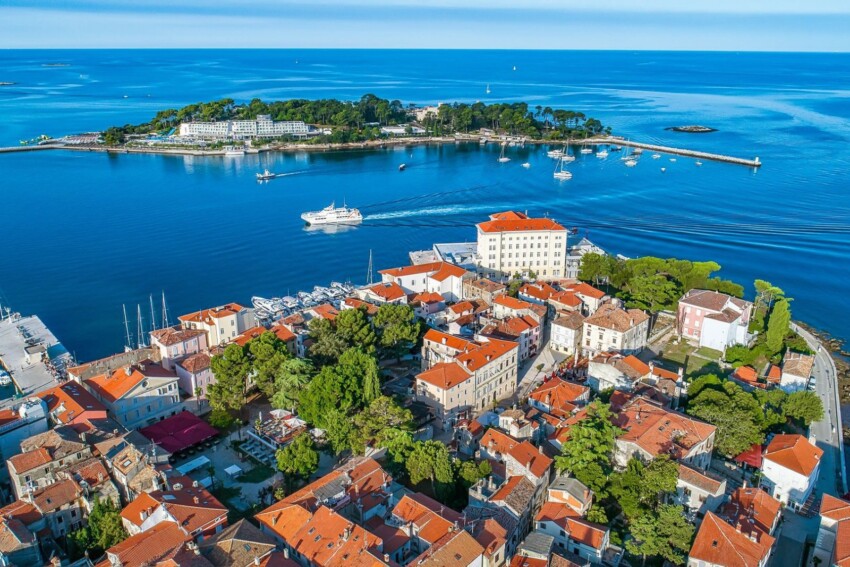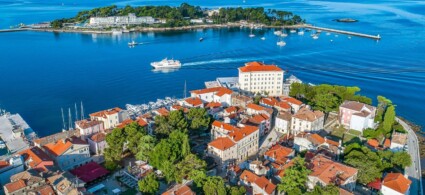

One of Croatia’s most popular tourist areas is undoubtedly Istria (Istra in Croatian), a vast heart-shaped peninsula stretching out into an incredibly clean and transparent Adriatic.
Easily accessible by car due to its proximity to the rest of Europe, Istria boasts a tourism industry that has been developed over decades, with a wide choice of accommodation and tourist services, making it an excellent choice for those who want to organise a stress-free holiday on their own.
True, its beaches are not the most beautiful in Croatia, but you can easily find a terrace to lie in the sun with easy access to the sea for a refreshing dip, and if you take the trouble to go a little further than the city beaches you’ll find quiet coves and delightful nooks and crannies all to yourself.
The Istrian peninsula is a region of northern Croatia that stretches into the Adriatic Sea between the Gulf of Trieste and the Kvarner Gulf. Behind it lie the mountains of the Julian and Dinaric Alps.
It has a large surface area of about 3,600 km² and its administrative capital is Pula. A small part of Istria, including the town of Koper, belongs to Slovenia and another small area to Italy.
Before or after the beach you can visit the region’s important historical and cultural sights, including the splendid Pula Arena; if you have time left, head inland into Istria’s less famous but not without charm.

Pula, the capital of the Istrian peninsula, is an alluring coastal city remembered by all for its iconic Roman amphitheatre with the sea in the background.
Pula arena is not the only evidence of Roman times that you can see in the city: strolling through the old town you can admire the remains of Roman walls, a temple dedicated to Augustus and a triumphal arch.
There is a good choice of beaches in the vicinity, where you can sunbathe or keep fit with a variety of evening activities, while in the evening you can enjoy yourself in one of the clubs in the centre.
Pula is a good base from which to explore other famous Istrian towns such as Porec or Rovinj; other interesting nearby attractions, perfect for a day trip, are Kamenjak Park, the village of Medulin and the Brijuni Islands.

Romantic Rovinj is a picturesque town with an old centre enclosed within a small peninsula where you can walk through narrow, winding streets, narrow houses with characteristic chimneys, alleys and small squares.
To learn about an important aspect of the town’s history, visit the original Batana Museum, dedicated to the traditional flat-bottomed boats typical of the area, where you will find a number of original models on display along with other fishing paraphernalia.
Along the coast of Rovinj you will find numerous beaches, coves and bays where you can spend a relaxing day. If you are looking for some coolness, visit the Punta Corrente Forest Park, which is easily accessible on foot from the centre with a relaxing seaside walk.

Probably the most visited of the Istrian resorts, Porec has everything a tourist could wish for: a wide choice of hotels and resorts in various price ranges, a lovely old town, crystal clear sea, a beautiful town beach and numerous others in the surrounding area, both developed and wild.
The architectural marvel of the town is the Euphrasian Basilica, a Unesco World Heritage Site: come in and admire its beautifully preserved Byzantine mosaics.
Porec is also the perfect destination for young people looking for fun thanks to its wild nightlife and legendary clubs where internationally renowned DJs play, and for lovers of a wide variety of sports such as windsurfing, water skiing, diving, sailing, kayaking, hiking, mountain biking, parachuting, climbing, caving and many more.

With its wide range of tourist services, Istria is an ideal destination for those who want to reach the beach comfortably, without stress. However, there is no shortage of more secluded and wilder beaches, perfect for those who don’t like the hustle and bustle.
Istria ‘s beaches are mainly pebbles or rocks, while the city beaches are generally cemented terraces. Sandy beaches are rarer but can be found.
Some of the most beautiful beaches in Istria include Kolumbarica Beach in Kamenjak Nature Park, Punta Verudela Beach, Brulo Beach and Bellevue Beach in Porec, Baluota Beach in Rovinj, Lone Bay and Porton Biondi Beach.
You won’t have any difficulty finding accommodation for your holiday in Istria. The tourist industry is highly developed, so there is a wide range of places to stay in this region. You can choose from hotels of various categories, luxury resorts, budget hotels and flats.
The tradition of room rentals, or sobe, which are a cheap but comfortable solution, still survives. The number of hostels, which are recommended for those who want to minimise their holiday budget, is increasing compared to the past, but the availability of hostels is still not very large.
As you can easily guess, along the coast, where the main tourist resorts of the region are concentrated, there is a greater availability of hotels, private rooms, holiday homes, resorts and campsites (including the new types of luxury campsites or glamping).
However, if you are looking for something special, you can go inland, which is still untrodden by mass tourism, and sleep in a charming country house surrounded by greenery and far from the hustle and bustle of the most famous tourist resorts.
We would like to remind you that it is always advisable to book in advance, especially if you are travelling in the months with the highest number of tourists, i.e. July and August.
Istria can be reached by car from the rest of Europe, and some international bus companies connect Pula, Poreč and Rovinj to the main cities. A change may be necessary, but generally the total journey time does not exceed eight hours. There are no train connections, however.





